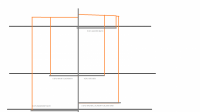I am remodeling my bathroom and I plan to replace all of the pin holing cast iron I have. The bathroom is on the first floor and I plan to replace all of the cast iron from the roof down to just above the basement floor. currently its 3" cast iron pipe. I will be adding a basement bath a couple months from now and I also might add a master bath down the road a year or two from now.
Currently it is:
- kitchen sink
- bathroom
- sink
- toilet
- shower/tub
This is all on a 3" cast iron.
I plan to add in 3-6 months:
- basement bath
- shower
- toilet
- sink
- bar sink
Possibly adding 1-2 years from now:
- master bath
- shower
- tub
- toilet
- double vanity
Since I plan to add more I am pretty sure I should use 4" PVC for the main stack, when I go to do the basement bath I will crack the floor and replace the rest of the cast iron to the outside. The connection will be about 3-6 ft above the basement floor and vertical, and I can place a clean-out above. It will only be temporary till I crack the floor.
so my main questions are:
Is it going to be a problem going from 4" PVC to the 3" cast iron on the vertical run for a couple months?
Is a clean out above needed?
do I even need 4" PVC with the above future load?
Any recommendations for coupling the 4" PVC to 3" cast iron?
Final question is for the first floor bathroom. I want to hide the toilet sewer line in the floor joists till it gets to the basement wall about 3-4 ft at a 1/4" per foot that's about a 1" drop. When going to the wall it will be perpendicular to the wall, and when it gets to the wall I need it to run change direction 90 degrees and drop under the floor joist and run parallel with the wall.
Will I run into any flow problems with this drop and direction change, how far should or could it drop?
Or is this a no no, and I should just slope it to the main line and bulk head it?
(I really don't have much head room as it is in the basement about 7ft exact without drywall and flooring.)
Thanks ahead for the help!
Currently it is:
- kitchen sink
- bathroom
- sink
- toilet
- shower/tub
This is all on a 3" cast iron.
I plan to add in 3-6 months:
- basement bath
- shower
- toilet
- sink
- bar sink
Possibly adding 1-2 years from now:
- master bath
- shower
- tub
- toilet
- double vanity
Since I plan to add more I am pretty sure I should use 4" PVC for the main stack, when I go to do the basement bath I will crack the floor and replace the rest of the cast iron to the outside. The connection will be about 3-6 ft above the basement floor and vertical, and I can place a clean-out above. It will only be temporary till I crack the floor.
so my main questions are:
Is it going to be a problem going from 4" PVC to the 3" cast iron on the vertical run for a couple months?
Is a clean out above needed?
do I even need 4" PVC with the above future load?
Any recommendations for coupling the 4" PVC to 3" cast iron?
Final question is for the first floor bathroom. I want to hide the toilet sewer line in the floor joists till it gets to the basement wall about 3-4 ft at a 1/4" per foot that's about a 1" drop. When going to the wall it will be perpendicular to the wall, and when it gets to the wall I need it to run change direction 90 degrees and drop under the floor joist and run parallel with the wall.
Will I run into any flow problems with this drop and direction change, how far should or could it drop?
Or is this a no no, and I should just slope it to the main line and bulk head it?
(I really don't have much head room as it is in the basement about 7ft exact without drywall and flooring.)
Thanks ahead for the help!

